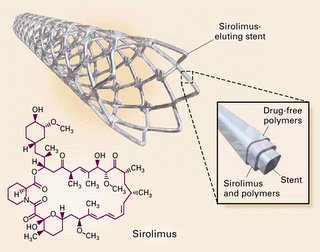What are Drug Eluting Stents
This is part 2 of the series on Drug Eluting Stents. We covered an introduction in part one here.
A DES is a stainless steel stent with a coating of complex polymers on it, on which drugs are embedded. The coating on the stainless steel allows for even, uniform release of the drugs so that there will be uniform, sustained release of the drug, to reduce scar tissue formation. It is therefore important to note that drug-eluting stents are a complex of stainless steel, the polymer-coating, and the drug. Right at the bottom is a stent which gives you the same results as the BMS. Riding on top is a polymewr coating which exists to hold the drug. This base is very important (almost as important as the drug) because it controls the uniform release of the drug over the crucial scar tissue formation phase of the re-blockage. Too rapid or too slow release will affect the performance of the drug-eluting stent. Above the polymer sits the drug compound.
Right at the bottom is a stent which gives you the same results as the BMS. Riding on top is a polymewr coating which exists to hold the drug. This base is very important (almost as important as the drug) because it controls the uniform release of the drug over the crucial scar tissue formation phase of the re-blockage. Too rapid or too slow release will affect the performance of the drug-eluting stent. Above the polymer sits the drug compound.
Many compounds were tried. Most of the compounds tried act by controlling cell multiplication. Remember that cancers are basically uncontrolled cell multiplication, it is therefore not surprising that some of the compounds tried as drugs for the stent are anti-cancer agents. By their very nature, they either stop cells from multiplying (like sirolimus, the drug in cypher) or they kill cells (like paclitaxel, the drug in taxus). The –olimus group seems the popular agent, as they are widely used in different types of DES like everolimus in the XienceV stent (Guidant) or the Zitarolimus in the Endevour stent (AVE Medtronic). The cypher stent is arguably the most studied DES and probably has the best results of all the DES so far, with the least adverse reaction.
No comments:
Post a Comment